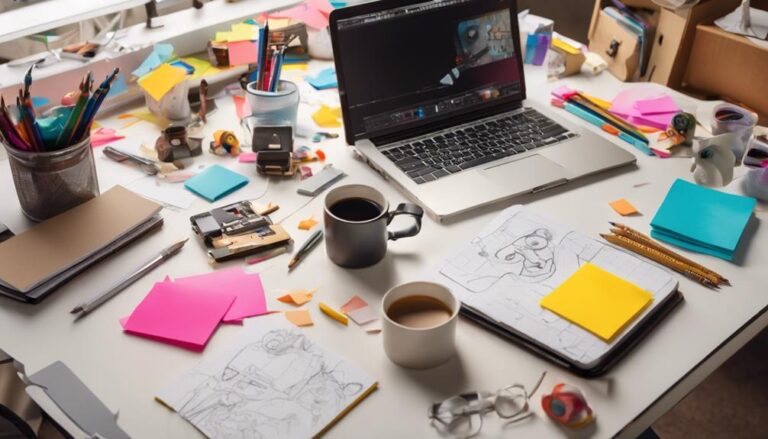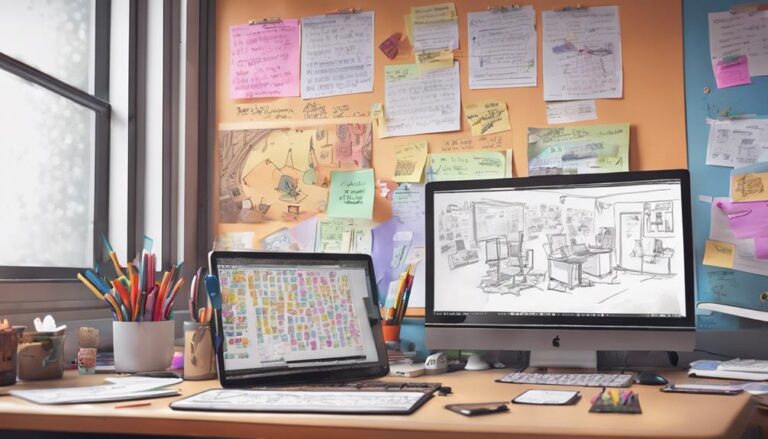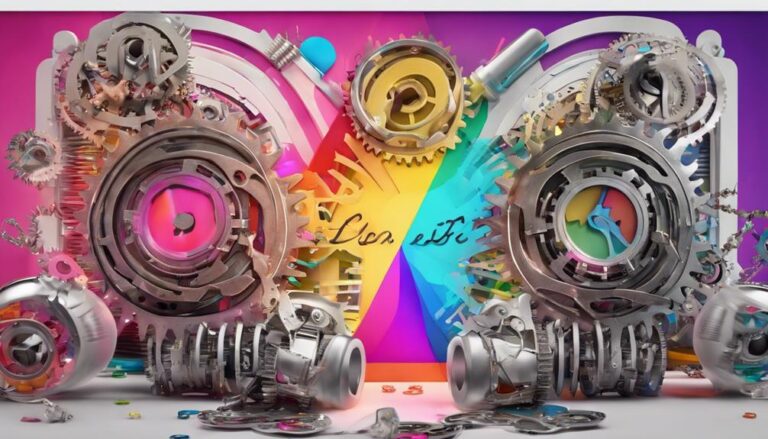Traditional Animation Techniques for TV Shows Explained
You'll find that traditional animation techniques for TV shows involve several key steps, starting with refining character designs and creating model sheets to maintain consistency. Storyboarding and planning for character movements and special effects come next, followed by defining keyframes to capture critical points in a character's movement. From there, traditional inking and painting techniques are applied to bring lines to life, before moving on to background design elements that establish atmosphere and mood. Understanding these processes is just the beginning, and as you move forward, you'll uncover more techniques that can help you achieve professional-quality animation.
Key Takeaways
- Refine character designs to ensure visual appeal and functionality for movement in traditional animation techniques.
- Create model sheets to maintain consistency in proportions, poses, and expressions of characters.
- Storyboarding techniques help break down the script into visual sequences and plan camera angles for TV shows.
- Keyframe animation involves defining critical points in a character's movement or action to achieve desired motion.
- Traditional inking and painting involve transferring pencil drawings onto celluloid sheets using ink lines and master brush control.
Hand-Drawn Animation Process
The animator's hand is the primary tool in the hand-drawn animation process.
As you begin, you'll start by refining your character designs, ensuring they're both visually appealing and functional for movement. This involves creating model sheets to maintain consistency in proportions, poses, and expressions.
Once your characters are finalized, you'll move on to storyboarding techniques. This crucial step involves breaking down the script into visual sequences, planning camera angles, and pacing.
You'll use these techniques to create a cohesive narrative flow, block out character movements, and plan for any necessary special effects. Your storyboard will serve as a blueprint for the entire animation process.
As you progress, you'll need to consider factors like timing, spacing, and motion.
You'll use these elements to bring your characters to life, creating the illusion of movement through carefully crafted drawings. By mastering these fundamental aspects of hand-drawn animation, you'll be well on your way to creating engaging, high-quality animations that captivate your audience.
Keyframe Animation Techniques
As you delve into keyframe animation techniques, a fundamental aspect of traditional animation, you'll define the most critical points in a character's movement or action – typically the beginning, middle, and end.
These keyframes serve as the foundation for the entire animation sequence, providing the essential poses and positions that bring a character to life.
When creating keyframes, it's essential to consider the frame rate of your animation, which is typically 24 or 30 frames per second.
By carefully planning and spacing your keyframes, you can achieve the desired motion and pacing for your scene. This process requires a deep understanding of timing, spacing, and motion principles.
In some cases, motion capture technology can be used to record and translate real-world movements into keyframe data.
This technique can be particularly useful for complex movements or performances that would be difficult to achieve through traditional keyframe animation.
Traditional Inking and Painting
Once you've established a solid foundation with keyframe animation techniques, it's time to focus on refining your traditional animation with inking and painting.
This process involves transferring your pencil drawings onto a transparent celluloid sheet using a range of ink lines, from fine details to bold outlines. Brush control is crucial in achieving the desired line quality, as varying brushstrokes can significantly impact the overall aesthetic of your animation.
Experiment with different brush types and techniques to master the subtleties of line art.
When it comes to painting, understanding color theory is essential. You'll need to select a color palette that complements your characters and environment.
Consider the mood, atmosphere, and emotional tone you want to convey in each scene. Apply your colors using water-based paints or digital tools, carefully balancing hue, saturation, and value to achieve the desired visual effect.
Pay attention to color harmony, contrast, and texture to create visually appealing and engaging scenes. By mastering traditional inking and painting, you'll add depth, richness, and emotion to your animation, elevating the overall quality of your TV show.
Background Design Elements
Effective background design elements are crucial in establishing the atmosphere and mood of your animation.
As you create your backgrounds, consider the texture styles that will help to immerse your audience in the world you're building. You can use a variety of techniques, such as watercolor, gouache, or even digital painting, to achieve the desired look. The texture styles you choose will greatly impact the overall feel of your animation, so it's essential to select them carefully.
Environmental storytelling is also a critical aspect of background design. The backgrounds you create shouldn't only be visually appealing but also tell a story about the characters and their world.
Consider the props, architecture, and other details that can be used to reveal character traits, backstory, and themes. By incorporating these elements, you can create rich, immersive backgrounds that draw your audience in and enhance the overall narrative of your animation.
Remember to balance these elements with negative space to avoid overwhelming the viewer and maintain visual clarity.
Cel Animation Production
With a solid understanding of background design elements, you're now ready to bring your characters to life through cel animation production.
This labor-intensive process involves creating multiple hand-drawn or hand-painted cels, each representing a single frame of animation. You'll need to carefully plan and execute the animation by breaking down the movement into individual frames, ensuring smooth transitions between them.
Once you've created the cels, you'll need to store them in a way that prevents damage and keeps them organized.
A cel storage system typically consists of airtight containers or shelves that protect the cels from dust, moisture, and light. This system also allows you to easily locate and retrieve specific cels during the production process.
In recent years, traditional animation techniques have been supplemented by animation software, which can help streamline the process.
These programs enable you to create digital versions of your cels, experiment with different animation techniques, and even composite your cels with the background elements you designed earlier.
Frequently Asked Questions
How Long Does Traditional Animation Take to Produce?
When producing animated content, you'll find that traditional animation's production timeline varies greatly. A typical studio workflow can take anywhere from 6-24 months per season, depending on the episode count, style, and complexity of the show you're working on.
What Software Aids Traditional Animation Techniques?
You'll find software like Adobe Animate, Toon Boom Harmony, and OpenToonz aid your workflow by offering digital drawing tools and software shortcuts, streamlining your production process and increasing efficiency in creating high-quality animations.
Are Traditional Animators Still in Demand Today?
You're likely to find traditional animators in demand due to industry trends valuing unique, handcrafted styles and artistic value, as many studios seek to differentiate their content with nostalgic, high-quality visuals.
Can Traditional Animation Be Outsourced Overseas?
When outsourcing animation, you face challenges like cultural differences and language barriers, which can hinder project communication and consistency, requiring you to establish clear guidelines and robust project management to ensure desired results.
What Is the Cost of Traditional Animation Production?
You'll find traditional animation costs vary widely, but when calculating costs, consider budget constraints and studio overhead, including labor, equipment, and facility expenses, which can add up to $50,000 to $200,000 per hour of content produced.
Conclusion
You now possess a foundational understanding of traditional animation techniques used in TV shows. The hand-drawn animation process, keyframe animation, inking and painting, background design elements, and cel animation production all come together to create visually stunning and engaging content. By mastering these techniques, you can bring your animation ideas to life, leveraging the expertise of legendary animators while incorporating your own unique style and vision.






